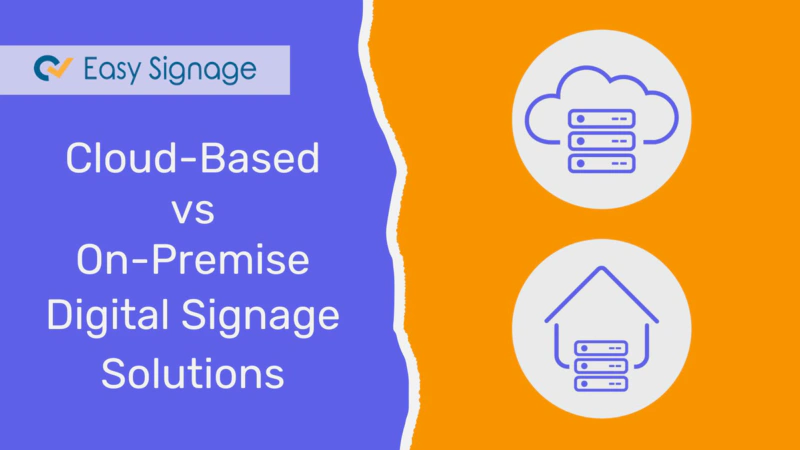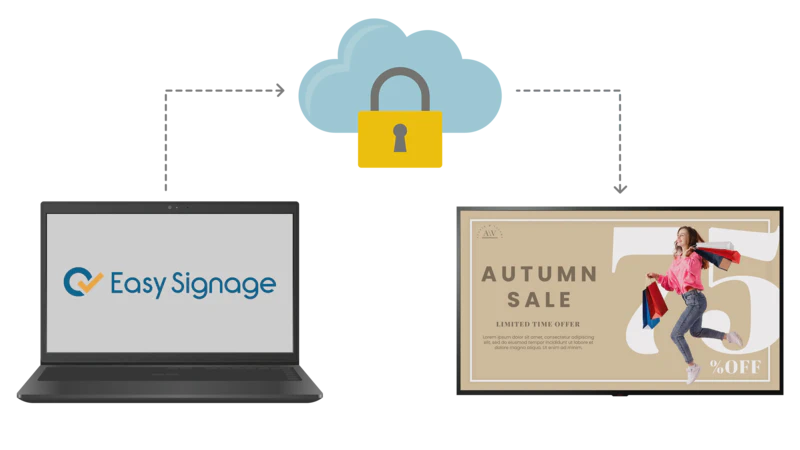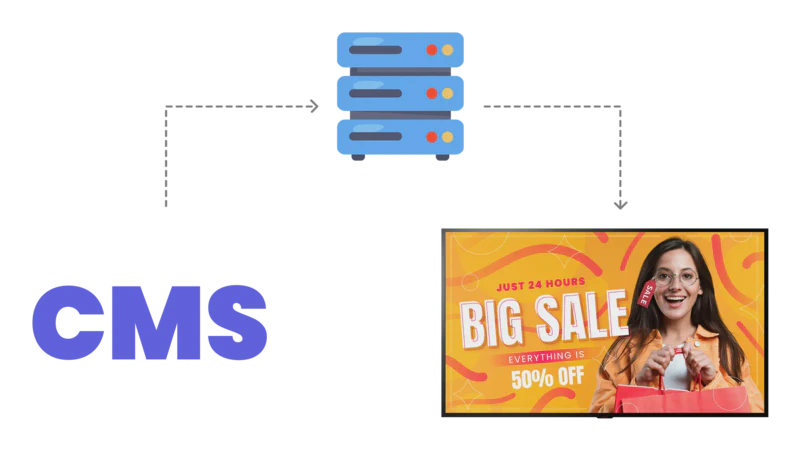Cloud-Based vs On-Premise Digital Signage Solutions

Digital signage has changed the way businesses and organisations communicate with their internal and external audiences, from advertising and live streaming to news tickers. As a result, digital signage has become popular in many companies and institutions, catering to both B2B (business-to-business) and B2C (business-to-consumer) markets.
If an organisation has decided to take advantage of digital signage, a key question arises: should they opt for an on-premise solution (self-hosted) or a cloud-based digital signage system as a service (SaaS)?
In this post, we’ll look at both options to help you decide which one best meets your needs.
What is Cloud-Based Digital Signage?
Cloud-based digital signage is a solution that works online, allowing users to manage screen content from any location with internet access. All content is stored and distributed through remote cloud servers, eliminating the need for big local servers in offices.
This system usually works on a subscription basis. The service provider handles server maintenance, updates, and security, making it accessible and efficient for businesses.
Users can upload, schedule, and update content on multiple screens in real-time through a web dashboard. This makes it perfect for various places like shops, corporate offices, schools, and more. It’s an ideal choice for companies seeking flexibility, easy growth, and less equipment on-site.
Benefits of Cloud-Based Digital Signage Systems
In cloud-based digital signage solutions, content is stored online and managed through a web browser. This means you don’t need expensive hardware or heavy maintenance.
A remote service provider handles everything, with the servers located off-site. This setup enables your content to be sent to any screen or player. As a result, the client can focus on other aspects of their business.
The benefits of a cloud-based system are more than just saving money. In addition to reducing initial investment costs, cloud-based solutions also ensure that the organisation doesn’t need a special team to manage and control the system.
Key advantages include:
Automatic Updates
Software updates happen automatically on all connected devices. If the software needs an update, the service provider will handle it. The client does not need to worry or do anything.
Low Initial Investment
Cloud-based systems greatly reduce the upfront cost because you don’t need much hardware or software, and you don’t need a special team to manage everything on-site. At EasySignage, we often see that clients choose the SaaS (Software as a Service) model because it’s easy to scale.
When a business grows, adding more screens and devices can be expensive. But with cloud-based systems, growing your setup is simple and doesn’t require a big investment. This is why many startups and fast-growing companies prefer cloud-based digital signage.
Real-Time Content
Cloud-based systems are great at showing time-sensitive information like weather reports, news, or dynamic food menus on many screens at the same time. They make sure your content is always fresh and shared instantly. They’re perfect for content like live stock prices, news feeds, and weather updates.
Many Easysignage users ask if they can show their existing content in different formats. The good news is that most cloud-based systems can quickly convert almost any file into a display-ready format without any hassle.

Key Considerations for Choosing Cloud-based Solutions
If you’re convinced of the benefits of a cloud-based digital signage system, the next step is to choose a provider with the right expertise and experience. Consider factors such as:
Offline Functionality:
One of the important features you should make sure that the system supports is offline operation, where your player can download and locally playback content offline, which guarantees system availability without constant internet access 24/7 or during internet outages.Data Security:
Opt for providers with proven security measures to protect your content and customer data. The service provider should have a proven ability to scale systems quickly.User-Friendly Interface:
An easy-to-navigate dashboard simplifies content management, making it accessible for all team members.Reliable Support:
Pay close attention to the level of support the software provider offers. A solid support system is essential for troubleshooting and scaling.
Only after considering these factors should you select a vendor for your digital signage systems.
What is On-Premise Digital Signage?
On-premise digital signage, also known as on-site digital signage, runs on the company’s own local servers. This gives the business full control over its data and keeps everything private. To use this setup, a server must be installed at every location where the screens are used.
With on-premise systems, the in-house IT team handles everything: data management, updates, and troubleshooting. This offers strong privacy but also requires more time, money, and technical work. The big advantage is that businesses can fully customise the system to match their exact needs. This is especially useful for industries that need high security, strict control, or must follow specific regulations.
Although the initial setup can be expensive, many companies like the long-term stability and control that on-premise solutions provide.

Key Considerations for On-Premise Solutions
Initially, digital signage, like many IT solutions, was primarily on-premise.This was before the rise and popularity of SaaS or Software as a Service, where both the hardware and software were physically based at the client’s location. This setup required significant initial investments and ongoing maintenance.
Key considerations include:
Control and Ownership:
On-premise solutions provide full control over system management and data, ensuring complete privacy and security.Initial and Ongoing Costs:
Although setup can be expensive, organisations must also face maintenance costs and the need for regular updates to keep hardware and software up to date.Technical Requirements:
Dedicated IT resources are necessary for management, making this approach less suitable for companies focused on other core areas.
Cloud-based vs On-premise Digital Signage
Now, let’s do a brief comparison of cloud-based and on-premise digital signage solutions to understand their core difference and to see how each stacks up in terms of setup, maintenance, scalability, security, and cost. This comparison will help clarify which option best aligns with your organisation’s specific needs.
1. Setup:
Cloud-Based: Hosted by a third party, accessible from anywhere with internet access. Scalable and perfect for businesses prioritising flexibility.
On-Premise: Hosted locally on company servers, offering more control and potentially enhanced security, suitable for industries with strict data requirements.
2. Maintenance:
Cloud-based: These systems require minimal hardware upgrades and come with managed updates and support from the provider, reducing IT demands.
On-Premise: On-premise systems need significant initial investment in hardware, ongoing manual upgrades, and dedicated IT resources for maintenance and updates, offering full control but at a higher cost and increased responsibility as the business expands.
3. Scalability:
Cloud-based: Easily scalable, allowing new screens or locations to be added instantly through the provider’s infrastructure.
On-Premise: Limited scalability, requiring manual adjustments, and often needing additional hardware and setup for expansion.
4. Security:
Cloud-based: Offers provider-managed, high-standard security protocols but depends on the provider’s infrastructure.
On-Premise: Provides full internal control that keeps data in-house, allowing customisation for high-security measures but requires IT resources for ongoing security and protection.
5. Cost:
Cloud-based: Generally subscription-based with lower initial costs. This pay-as-you-go model helps manage costs, but expenses can accumulate over time.
On-Premise: Requires a high initial investment for hardware and setup, but eliminates ongoing subscription fees, making long-term costs more predictable.
6. Future-Proofing and Updates
Cloud-based: Automatic updates keep the system up-to-date with the latest features and security enhancements.
On-Premise: Stability is a plus, but updates can be costly, potentially impacting long-term adaptability.
Conclusion
Digital signage is rapidly evolving, and choosing between cloud-based and on-premise digital signage solutions is a critical decision and depends on your organisation’s goals.
Cloud solutions are great for flexibility and ease, while on-premise offers robust control and potentially enhanced security.
If you’re considering cloud-based digital signage, EasySignage is an excellent choice. As a Google Cloud partner, EasySignage delivers secure, scalable digital signage solution via Google Cloud. With industry-leading security and global availability, EasySignage provides businesses with the reliability they need for effective digital display management.
Sign up today for forever-free digital signage at EasySignage.